Intercomparison of CH4 Products in China from GOSAT, TROPOMI, IASI, and AIRS Satellites
Abstract
:1. Introduction
2. Materials and Methods
2.1. Data
2.1.1. Satellite CH4 Measurements
2.1.2. CH4 Emission Inventory
2.1.3. CAMS Global Greenhouse Gas Reanalysis (EGG4)
2.2. Methods
3. Results and Discussion
3.1. Spatial Distribution of CH4 in China
3.2. Intercomparison between Satellites
3.2.1. Comparison between the GOSAT and TROPOMI Measurements
3.2.2. Comparison between the IASI and AIRS Measurements
3.2.3. Comparison between the TROPOMI and AIRS Measurements
3.3. Temporal Variation of the Atmospheric CH4 in China
4. Conclusions
Author Contributions
Funding
Data Availability Statement
Acknowledgments
Conflicts of Interest
References
- Cao, Y.; Li, X.; Yan, H.; Kuang, S. China’s Efforts to Peak Carbon Emissions: Targets and Practice. Chin. J. Urban Environ. Stud. 2021, 9, 2150004. [Google Scholar] [CrossRef]
- IPCC. Climate Change 2013: The Physical Science Basis. Contribution of Working Group I to the Fifth Assessment Report of the Intergovernmental Panel on Climate Change; IPCC: Geneva, Switzerland, 2013. [Google Scholar]
- Ehhalt, D.H.; Schmidt, U. Sources and Sinks of Atmospheric Methane. Pure Appl. Geophys. 1978, 116, 452–464. [Google Scholar] [CrossRef]
- Hogan, K.B.; Hoffman, J.S.; Thompson, A.M. Methane on the Greenhouse Agenda. Nature 1991, 354, 181–182. [Google Scholar] [CrossRef]
- Stocker, T.F.; Qin, D.; Plattner, G.K.; Tignor, M.M.B.; Allen, S.K.; Boschung, J.; Nauels, A.; Xia, Y.; Bex, V.; Midgley, P.M. Working Group I Contribution to the Fifth Assessment Report of the Intergovernmental Panel on Climate Change 14; IPCC: Geneva, Switzerland, 2015. [Google Scholar]
- Solarin, S.A.; Gil-Alana, L.A. Persistence of Methane Emission in OECD Countries for 1750–2014: A Fractional Integration Approach. Environ. Model. Assess. 2021, 26, 497–509. [Google Scholar] [CrossRef]
- Zhang, J.; Han, G.; Mao, H.; Pei, Z.; Ma, X.; Jia, W.; Gong, W. The Spatial and Temporal Distribution Patterns of XCH4 in China: New Observations from TROPOMI. Atmosphere 2022, 13, 177. [Google Scholar] [CrossRef]
- Jacob, D.J.; Turner, A.J.; Maasakkers, J.D.; Sheng, J.; Sun, K.; Liu, X.; Chance, K.; Aben, I.; McKeever, J.; Frankenberg, C. Satellite Observations of Atmospheric Methane and Their Value for Quantifying Methane Emissions. Atmos. Chem. Phys. 2016, 16, 14371–14396. [Google Scholar] [CrossRef]
- Maasakkers, J.D.; Varon, D.J.; Elfarsdóttir, A.; McKeever, J.; Jervis, D.; Mahapatra, G.; Pandey, S.; Lorente, A.; Borsdorff, T.; Foorthuis, L.R.; et al. Using Satellites to Uncover Large Methane Emissions from Landfills. Sci. Adv. 2022, 8, eabn9683. [Google Scholar] [CrossRef]
- Qin, X.; Lei, L.; He, Z.; Zeng, Z.-C.; Kawasaki, M.; Ohashi, M.; Matsumi, Y. Preliminary Assessment of Methane Concentration Variation Observed by GOSAT in China. Adv. Meteorol. 2015, 2015, 125059. [Google Scholar] [CrossRef]
- Lei, L.; Liu, Q.; Zhang, L.; Liu, L.; Zhang, B. A Preliminary Investigation of CO2 and CH4 Concentration Variations with the Land Use in Northern China by GOSAT. In Proceedings of the 2010 IEEE International Geoscience and Remote Sensing Symposium, Honolulu, HI, USA, 25–30 July 2010; pp. 1141–1144. [Google Scholar] [CrossRef]
- Wang, H.; Li, J.; Zhang, Y.; Li, S.; Zhang, L.; Chen, L. Spatial and temporal distribution of near-surface methane concentration over China based on AIRS observations. J. Remote Sens. 2015, 19, 827–835. [Google Scholar] [CrossRef]
- Zhou, J.; Guan, L. Characteristics of Spatial and Temporal Distributions of Methane over the Tibetan Plateau and Mechanism Analysis for High Methane Concentration in Summer. Clim. Environ. Res. 2017, 22, 315–321. [Google Scholar] [CrossRef]
- Feng, D.; Gao, X.; Yang, L.; Hui, X.; Zhou, Y. A spatial-temporal distribution characteristics of the atmospheric methane in troposphere on Qinghai-Tibetan plateau using ARIS data. Chin. Environ. Sci. 2017, 37, 2822–2830. [Google Scholar] [CrossRef]
- Zhang, X.; Bai, W.; Zhang, P.; Wang, W. Spatiotemporal Variations in Mid-Upper Tropospheric Methane over China from Satellite Observations. Chin. Sci. Bull. 2011, 56, 3321. [Google Scholar] [CrossRef]
- Xu, Y.; Wang, J.; Sun, J.; Xu, Y.; Harris, W. Spatial and Temporal Variations of Lower Tropospheric Methane During 2010–2011 in China. IEEE J. Stars 2012, 5, 1464–1473. [Google Scholar] [CrossRef]
- Wu, X.; Zhang, X.; Chuai, X.; Huang, X.; Wang, Z. Long-Term Trends of Atmospheric CH4 Concentration across China from 2002 to 2016. Remote Sens. 2019, 11, 538. [Google Scholar] [CrossRef]
- Kuze, A.; Suto, H.; Nakajima, M.; Hamazaki, T. Thermal and near Infrared Sensor for Carbon Observation Fourier-Transform Spectrometer on the Greenhouse Gases Observing Satellite for Greenhouse Gases Monitoring. Appl. Opt. 2009, 48, 6716. [Google Scholar] [CrossRef]
- Lorente, A.; Borsdorff, T.; Butz, A.; Hasekamp, O.; aan de Brugh, J.; Schneider, A.; Wu, L.; Hase, F.; Kivi, R.; Wunch, D.; et al. Methane Retrieved from TROPOMI: Improvement of the Data Product and Validation of the First 2 Years of Measurements. Atmos. Meas. Tech. 2021, 14, 665–684. [Google Scholar] [CrossRef]
- Crevoisier, C.; Nobileau, D.; Fiore, A.M.; Armante, R.; Chédin, A.; Scott, N.A. Tropospheric Methane in the Tropics—First Year from IASI Hyperspectral Infrared Observations. Atmos. Chem. Phys. 2009, 9, 6337–6350. [Google Scholar] [CrossRef]
- Xiong, X.; Barnet, C.; Maddy, E.; Sweeney, C.; Liu, X.; Zhou, L.; Goldberg, M. Characterization and Validation of Methane Products from the Atmospheric Infrared Sounder (AIRS). J. Geophys. Res. Biogeosci. 2008, 113, JG000500. [Google Scholar] [CrossRef]
- Shi, C.; Hashimoto, M.; Shiomi, K.; Nakajima, T. Development of an Algorithm to Retrieve Aerosol Optical Properties Over Water Using an Artificial Neural Network Radiative Transfer Scheme: First Result From GOSAT-2/CAI-2. IEEE Trans. Geosci. Remote Sens. 2021, 59, 9861–9872. [Google Scholar] [CrossRef]
- Zhou, M.; Dils, B.; Wang, P.; Detmers, R.; Yoshida, Y.; O’Dell, C.W.; Feist, D.G.; Velazco, V.A.; Schneider, M.; De Mazière, M. Validation of TANSO-FTS/GOSAT XCO2 and XCH4 Glint Mode Retrievals Using TCCON Data from near-Ocean Sites. Atmos. Meas. Tech. 2016, 9, 1415–1430. [Google Scholar] [CrossRef]
- Imasu, R.; Matsunaga, T.; Nakajima, M.; Yoshida, Y.; Shiomi, K.; Morino, I.; Saitoh, N.; Niwa, Y.; Someya, Y.; Oishi, Y.; et al. Greenhouse Gases Observing SATellite 2 (GOSAT-2): Mission Overview. Prog. Earth Planet. Sci. 2023, 10, 33. [Google Scholar] [CrossRef]
- Butz, A.; Hasekamp, O.P.; Frankenberg, C.; Vidot, J.; Aben, I. CH4 Retrievals from Space-Based Solar Backscatter Measurements: Performance Evaluation against Simulated Aerosol and Cirrus Loaded Scenes. J. Geophys. Res. 2010, 115, JD014514. [Google Scholar] [CrossRef]
- Borsdorff, T.; Aan de Brugh, J.; Hu, H.; Aben, I.; Hasekamp, O.; Landgraf, J. Measuring Carbon Monoxide With TROPOMI: First Results and a Comparison With ECMWF-IFS Analysis Data. Geophys. Res. Lett. 2018, 45, 2826–2832. [Google Scholar] [CrossRef]
- Crevoisier, C.; Nobileau, D.; Armante, R.; Crépeau, L.; Machida, T.; Sawa, Y.; Matsueda, H.; Schuck, T.; Thonat, T.; Pernin, J.; et al. The 2007–2011 Evolution of Tropical Methane in the Mid-Troposphere as Seen from Space by MetOp-A/IASI. Atmos. Chem. Phys. 2013, 13, 4279–4289. [Google Scholar] [CrossRef]
- Qin, J.; Zhang, X.; Zhang, L.; Cheng, M.; Lu, X. Spatiotemporal Variations of XCH4 across China during 2003–2021 Based on Observations from Multiple Satellites. Atmosphere 2022, 13, 1362. [Google Scholar] [CrossRef]
- Miller, S.M.; Wofsy, S.C.; Michalak, A.M.; Kort, E.A.; Andrews, A.E.; Biraud, S.C.; Dlugokencky, E.J.; Eluszkiewicz, J.; Fischer, M.L.; Janssens-Maenhout, G.; et al. Anthropogenic Emissions of Methane in the United States. Proc. Natl. Acad. Sci. USA 2013, 110, 20018–20022. [Google Scholar] [CrossRef]
- Wang, F.; Maksyutov, S.; Janardanan, R.; Tsuruta, A.; Ito, A.; Morino, I.; Yoshida, Y.; Tohjima, Y.; Kaiser, J.W.; Lan, X.; et al. Atmospheric Observations Suggest Methane Emissions in North-Eastern China Growing with Natural Gas Use. Sci. Rep. 2022, 12, 18587. [Google Scholar] [CrossRef] [PubMed]
- Koffi, E.N.; Bergamaschi, P. Evaluation of Copernicus Atmosphere Monitoring Service Methane Products; Joint Research Centre: Ispra, Italy, 2018. [Google Scholar]
- Agusti-Panareda, A.; Barré, J.; Massart, S.; Inness, A.; Aben, I.; Ades, M.; Baier, B.C.; Balsamo, G.; Borsdorff, T.; Bousserez, N.; et al. Technical Note: The CAMS Greenhouse Gas Reanalysis from 2003 to 2020. Atmos. Chem. Phys. 2023, 23, 3829–3859. [Google Scholar] [CrossRef]
- Sadavarte, P.; Pandey, S.; Maasakkers, J.D.; Lorente, A.; Borsdorff, T.; van der Gon, H.D.; Houweling, S.; Aben, I. Methane Emissions from Superemitting Coal Mines in Australia Quantified Using TROPOMI Satellite Observations. Environ. Sci. Technol. 2021, 55, 16573–16580. [Google Scholar] [CrossRef]
- Plant, G.; Kort, E.A.; Murray, L.T.; Maasakkers, J.D.; Aben, I. Evaluating Urban Methane Emissions from Space Using TROPOMI Methane and Carbon Monoxide Observations. Remote Sens. Environ. 2022, 268, 112756. [Google Scholar] [CrossRef]
- Olioso, A.; Sòria, G.; Sobrino, J.; Duchemin, B. Evidence of low land surface thermal infrared emissivity in the presence of dry vegetation. IEEE Geosci. Remote Sens. Lett. 2007, 4, 112–116. [Google Scholar] [CrossRef]
- Qu, Z.; Jacob, D.J.; Shen, L.; Lu, X.; Zhang, Y.; Scarpelli, T.R.; Nesser, H.; Sulprizio, M.P.; Maasakkers, J.D.; Bloom, A.A.; et al. Global Distribution of Methane Emissions: A Comparative Inverse Analysis of Observations from the TROPOMI and GOSAT Satellite Instruments. Atmos. Chem. Phys. 2021, 21, 14159–14175. [Google Scholar] [CrossRef]
- Misra, V.; DiNapoli, S. The Variability of the Southeast Asian Summer Monsoon: Variability of the Southeast Monsoon. Int. J. Climatol. 2014, 34, 893–901. [Google Scholar] [CrossRef]
- Xiong, X.; Houweling, S.; Wei, J.; Maddy, E.; Sun, F.; Barnet, C. Methane Plume over South Asia during the Monsoon Season: Satellite Observation and Model Simulation. Atmos. Chem. Phys. 2009, 9, 783–794. [Google Scholar] [CrossRef]
- Hu, H.; Hasekamp, O.; Butz, A.; Galli, A.; Landgraf, J.; Aan De Brugh, J.; Borsdorff, T.; Scheepmaker, R.; Aben, I. The Operational Methane Retrieval Algorithm for TROPOMI. Atmos. Meas. Tech. 2016, 9, 5423–5440. [Google Scholar] [CrossRef]
- Zhang, G.; Xiao, X.; Dong, J.; Xin, F.; Zhang, Y.; Qin, Y.; Doughty, R.B.; Moore, B. Fingerprint of Rice Paddies in Spatial–Temporal Dynamics of Atmospheric Methane Concentration in Monsoon Asia. Nat. Commun. 2020, 11, 554. [Google Scholar] [CrossRef] [PubMed]

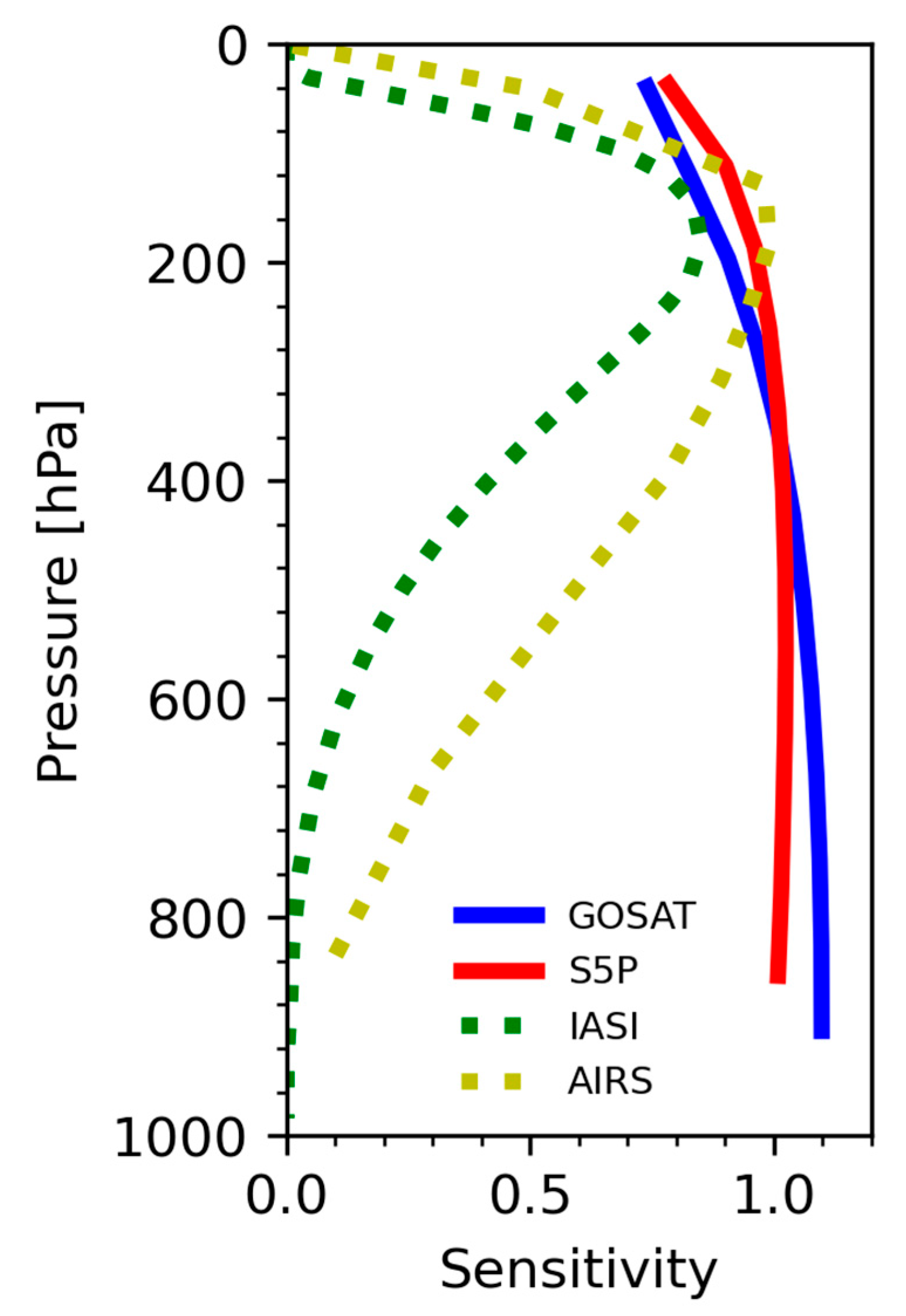



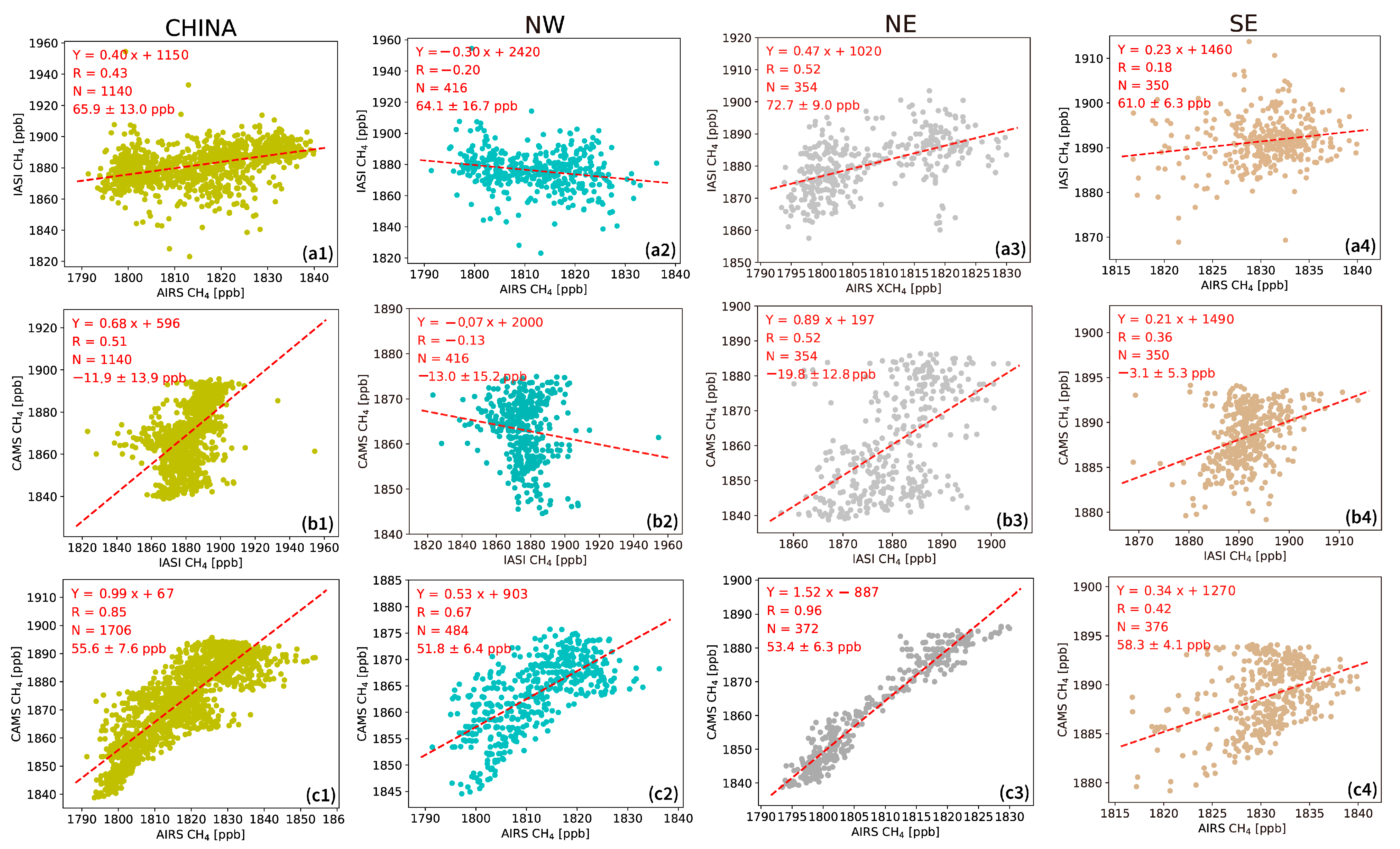
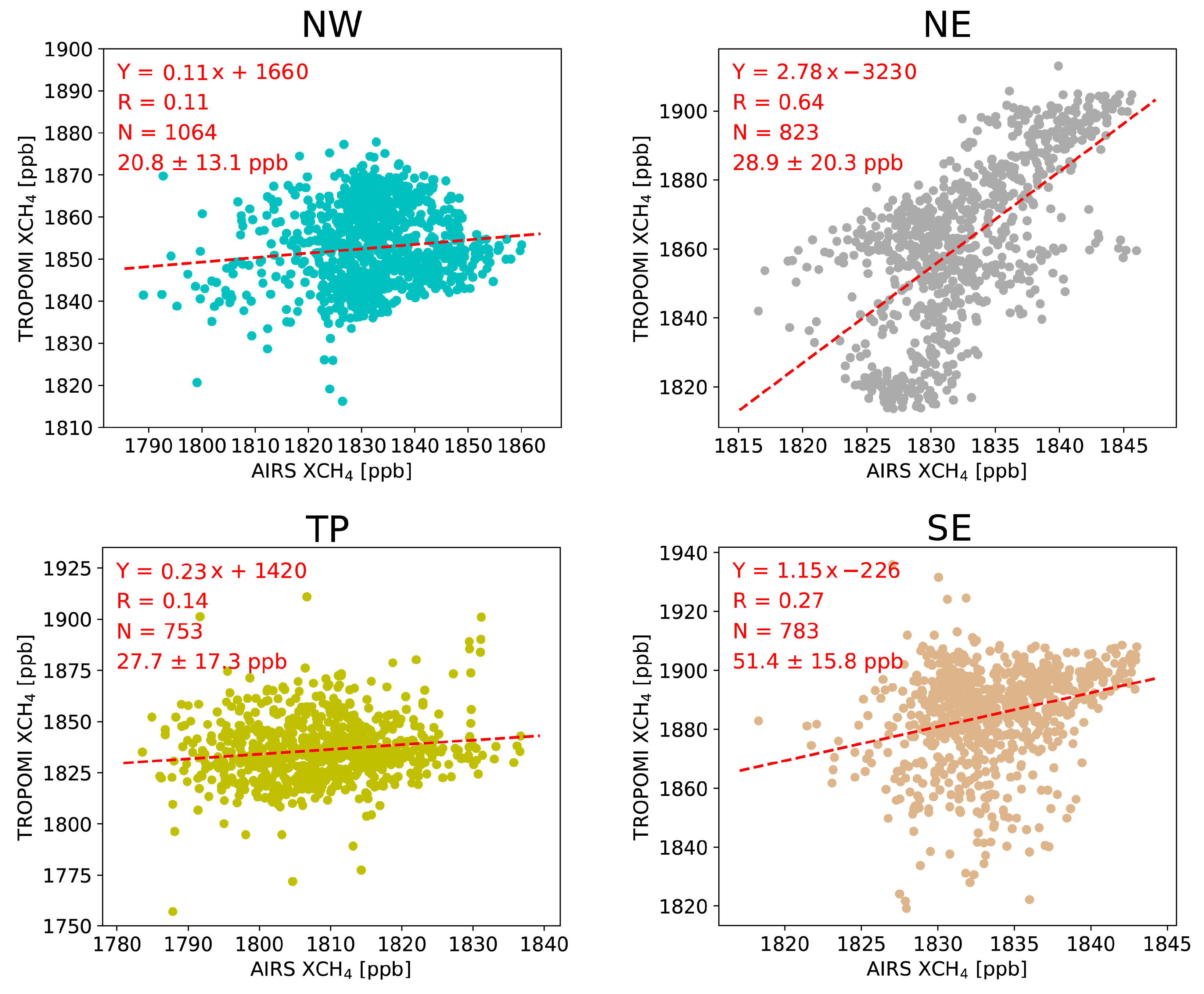
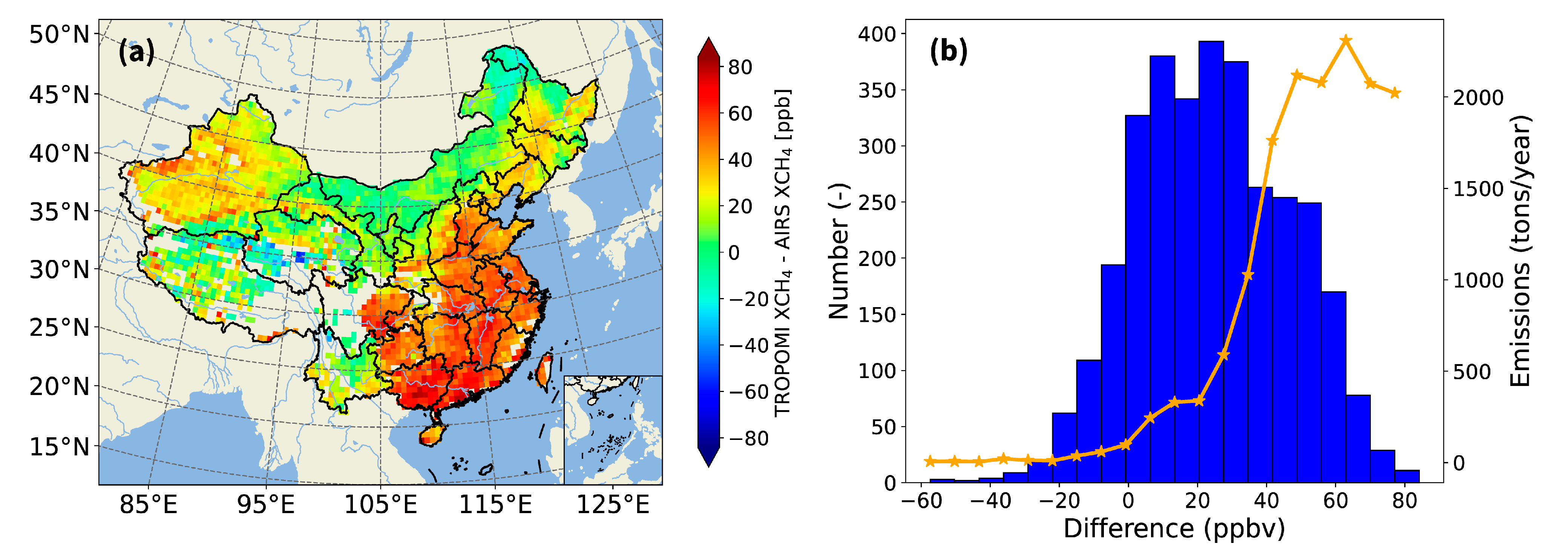
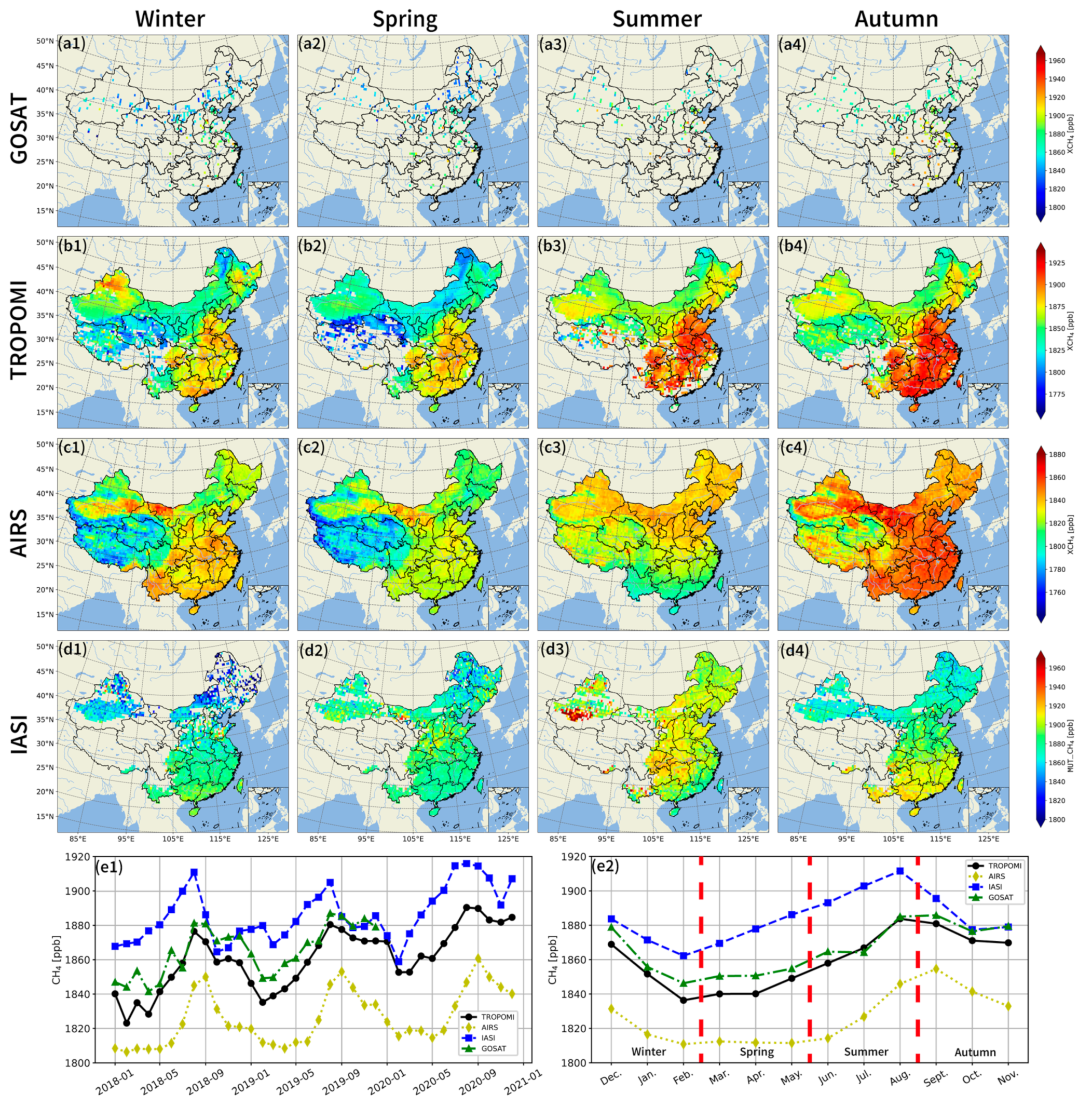
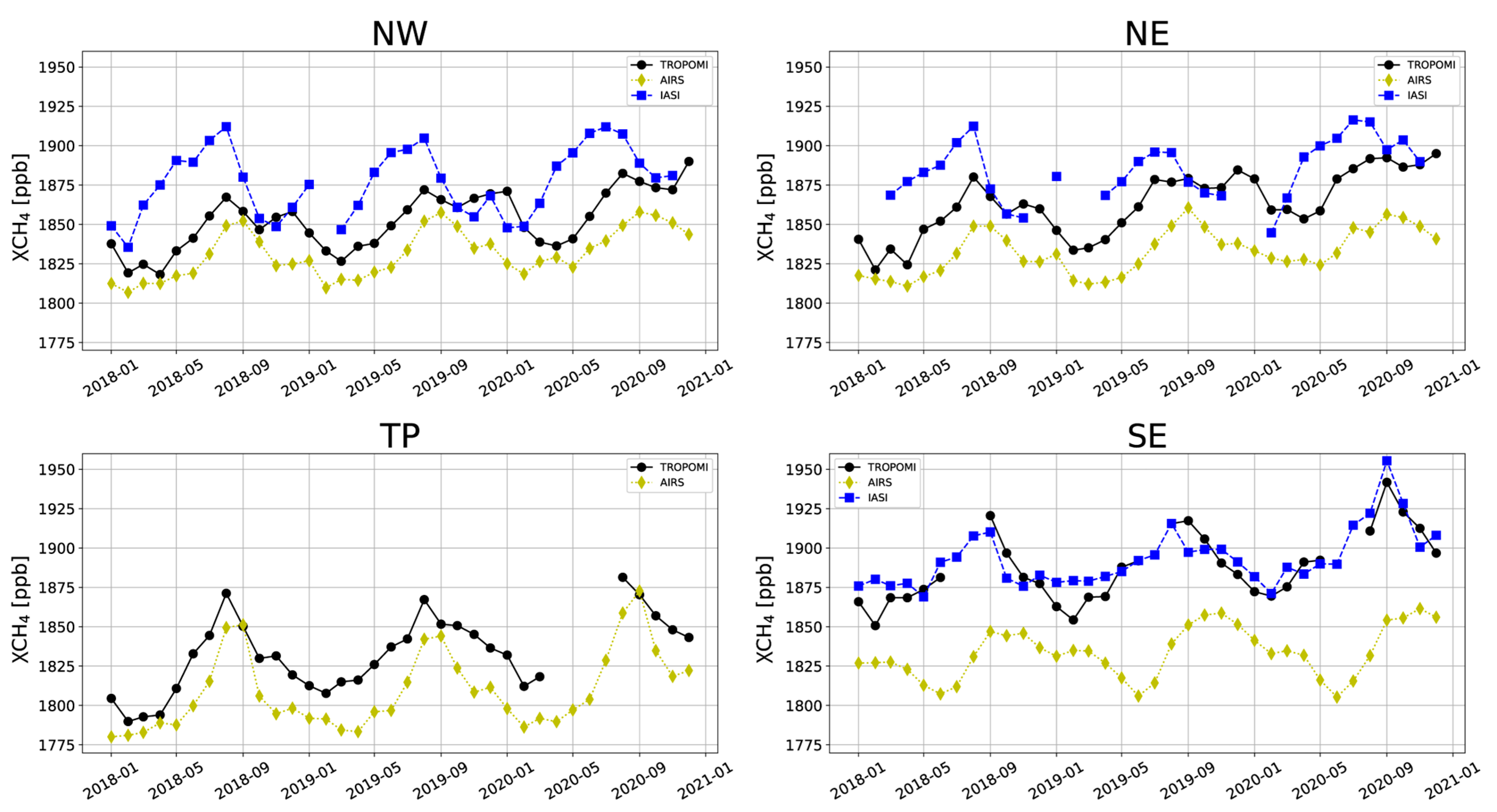
| Instruments | TANSO-FTS | TROPOMI | IASI | AIRS |
|---|---|---|---|---|
| Satellite | GOSAT | S5P | MetOp-A | Aqua |
| Agency | JAXA | ESA, NSO | EUMETSAT | NASA |
| Data period | 2009–now | 2017–now | 2007–now | 2002–now |
| Overpass time [local time] | 01:00/13:00 | 01:30/13:30 | 09:30/21:30 | 01:30/13:30 |
| Fitting window [nm] Spectral resolution | 1560–1720 0.27 cm−1 | 2310–2390 0.25 nm | 7100–8300 0.5 cm−1 | 6200–8200 0.5 cm−1 |
| Pixel size | 10.5 km | 5.5 × 7.0 km2 | 12 km | 13.5 km |
| Swath [km] | Discrete, 1–9 points | 2600 | 2200 | 1650 |
| Reference | Kuze et al. (2009) [18] | Lorente et al. (2021) [19] | Crevoisier et al. (2009) [20] | Xiong et al. (2008) [21] |
Disclaimer/Publisher’s Note: The statements, opinions and data contained in all publications are solely those of the individual author(s) and contributor(s) and not of MDPI and/or the editor(s). MDPI and/or the editor(s) disclaim responsibility for any injury to people or property resulting from any ideas, methods, instructions or products referred to in the content. |
© 2023 by the authors. Licensee MDPI, Basel, Switzerland. This article is an open access article distributed under the terms and conditions of the Creative Commons Attribution (CC BY) license (https://creativecommons.org/licenses/by/4.0/).
Share and Cite
Ni, Q.; Zhou, M.; Wang, J.; Wang, T.; Wang, G.; Wang, P. Intercomparison of CH4 Products in China from GOSAT, TROPOMI, IASI, and AIRS Satellites. Remote Sens. 2023, 15, 4499. https://doi.org/10.3390/rs15184499
Ni Q, Zhou M, Wang J, Wang T, Wang G, Wang P. Intercomparison of CH4 Products in China from GOSAT, TROPOMI, IASI, and AIRS Satellites. Remote Sensing. 2023; 15(18):4499. https://doi.org/10.3390/rs15184499
Chicago/Turabian StyleNi, Qichen, Minqiang Zhou, Jiaxin Wang, Ting Wang, Gengchen Wang, and Pucai Wang. 2023. "Intercomparison of CH4 Products in China from GOSAT, TROPOMI, IASI, and AIRS Satellites" Remote Sensing 15, no. 18: 4499. https://doi.org/10.3390/rs15184499
APA StyleNi, Q., Zhou, M., Wang, J., Wang, T., Wang, G., & Wang, P. (2023). Intercomparison of CH4 Products in China from GOSAT, TROPOMI, IASI, and AIRS Satellites. Remote Sensing, 15(18), 4499. https://doi.org/10.3390/rs15184499






